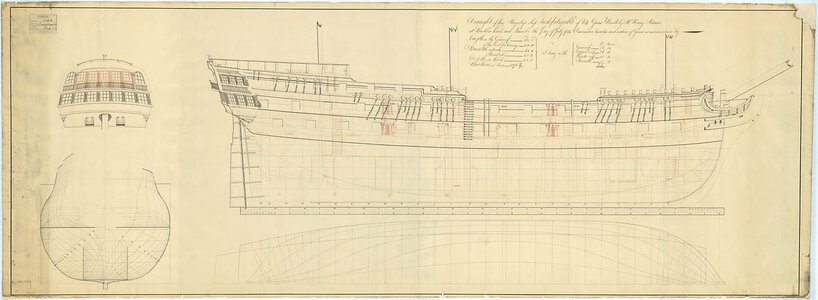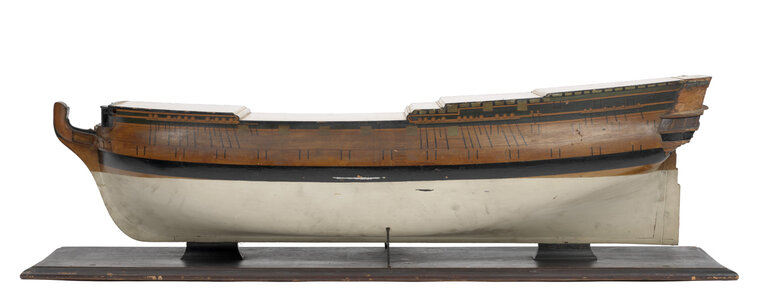Hallo@Kaycee ,
this sounds like a really very interesting project you try to make.
Due to the fact, that you are (as I understood) in the beginning of your research, I am maybe able to help with the hint to some existing contemporary drawings of this ship
Original configuration as 64 gunner:
View attachment 209167
Scale: 1:48. Plan showing the body plans, stern board outline with some decoration detail, sheer lines with inboard detail, and longitudinal half-breadth for Indefatigable (1784), a 64-gun Third Rate, two-decker, as built and launched at Bucklers Hard by Henry Adams. The ship was fitted at Portsmouth Dockyard between July and November 1784.

collections.rmg.co.uk
View attachment 209169
Scale: 1:48. Plan showing the body plan, sheer lines (with modified main mast position), and longitudinal half-breadth for 'Ardent' (1764), 'Raisonable' (1768), 'Belliqueux' (1780), 'Agamemnon' (1782), 'Indefatigable' (1784), 'Stately' (1784), and 'Nassau' (1785), all 64-gun Third Rate, two-deckers.

collections.rmg.co.uk
View attachment 209170
Scale: 1:48. Plan showing the imboard profile for 'Ardent' (1764), 'Raisonable' (1768) 'Belliqueux' (1780, 'Agamemnon' (1781), 'Indefatigable' (1784), 'Stately' (1784), and 'Nassau' (1785), all 64-gun Third Rate, two-deckers. The plan includes later (undated) alterations for converting a ship of this class to a troopship. The only ship to be converted was 'Nassau' (1785) in 1799.

collections.rmg.co.uk
View attachment 209171
Scale: 1:48. A contemporary block design model of the 64-gun, two-decker ship of the line ‘Indefatigable’ (1784). The number ‘2’ is painted on the base. The hull is painted white below the waterline and the locations of the gun ports and chain plates are painted on the side. The figurehead is in the form of a solid block. The ‘Indefatigable’ was built at Buckler’s Hard by Adams and designed by Sir T. Slade. It measured 160 feet along the gun deck by 44 feet in the beam, displacing 1384 tons. In 1794 it was reduced to a fifth rate and subsequently commissioned to patrol the Channel, capturing a number of French privateers in 1795–1800. In 1805 it took part in the blockade of Brest and in 1812–15 it was stationed in South America. It was broken up in 1816 at Sheerness.

collections.rmg.co.uk
Razeed as a 44 gun frigate
View attachment 209168
Sheer draught of HMS 'Indefatigable' dated to 1794 to show the proposal for cutting the the 64-gun Third Rate down to a frigate. In this process, the ship was 'razeed', and her upper deck was removed and she was reduced to an armament of 44 guns. On this plan, the ticked line represents the upper deck which was to be removed, and the solid lines represent her new design, internal fittings, are shown in red.

collections.rmg.co.uk
Also several paintings are existing
[U
Hallo@Kaycee ,
this sounds like a really very interesting project you try to make.
Due to the fact, that you are (as I understood) in the beginning of your research, I am maybe able to help with the hint to some existing contemporary drawings of this ship
Original configuration as 64 gunner:
View attachment 209167
Scale: 1:48. Plan showing the body plans, stern board outline with some decoration detail, sheer lines with inboard detail, and longitudinal half-breadth for Indefatigable (1784), a 64-gun Third Rate, two-decker, as built and launched at Bucklers Hard by Henry Adams. The ship was fitted at Portsmouth Dockyard between July and November 1784.

collections.rmg.co.uk
View attachment 209169
Scale: 1:48. Plan showing the body plan, sheer lines (with modified main mast position), and longitudinal half-breadth for 'Ardent' (1764), 'Raisonable' (1768), 'Belliqueux' (1780), 'Agamemnon' (1782), 'Indefatigable' (1784), 'Stately' (1784), and 'Nassau' (1785), all 64-gun Third Rate, two-deckers.

collections.rmg.co.uk
View attachment 209170
Scale: 1:48. Plan showing the imboard profile for 'Ardent' (1764), 'Raisonable' (1768) 'Belliqueux' (1780, 'Agamemnon' (1781), 'Indefatigable' (1784), 'Stately' (1784), and 'Nassau' (1785), all 64-gun Third Rate, two-deckers. The plan includes later (undated) alterations for converting a ship of this class to a troopship. The only ship to be converted was 'Nassau' (1785) in 1799.

collections.rmg.co.uk
View attachment 209171
Scale: 1:48. A contemporary block design model of the 64-gun, two-decker ship of the line ‘Indefatigable’ (1784). The number ‘2’ is painted on the base. The hull is painted white below the waterline and the locations of the gun ports and chain plates are painted on the side. The figurehead is in the form of a solid block. The ‘Indefatigable’ was built at Buckler’s Hard by Adams and designed by Sir T. Slade. It measured 160 feet along the gun deck by 44 feet in the beam, displacing 1384 tons. In 1794 it was reduced to a fifth rate and subsequently commissioned to patrol the Channel, capturing a number of French privateers in 1795–1800. In 1805 it took part in the blockade of Brest and in 1812–15 it was stationed in South America. It was broken up in 1816 at Sheerness.

collections.rmg.co.uk
Razeed as a 44 gun frigate
View attachment 209168
Sheer draught of HMS 'Indefatigable' dated to 1794 to show the proposal for cutting the the 64-gun Third Rate down to a frigate. In this process, the ship was 'razeed', and her upper deck was removed and she was reduced to an armament of 44 guns. On this plan, the ticked line represents the upper deck which was to be removed, and the solid lines represent her new design, internal fittings, are shown in red.

collections.rmg.co.uk
Also several paintings are existing










